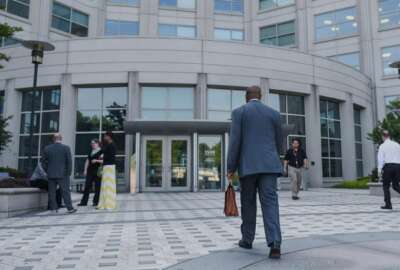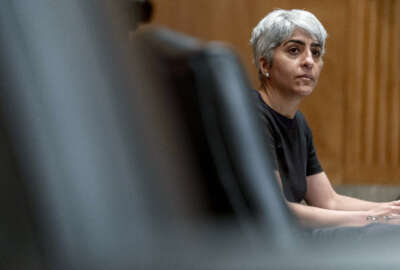
The administration’s new telework guidance is far from perfect
Guidance from the White House a couple of weeks ago seeks to get more federal employees back to their offices.
Guidance from the White House a couple of weeks ago seeks to get more federal employees back to their offices. It’s a big data-gathering exercise. To find out the pros and cons, Federal Drive with Tom Temin spoke with Bob Tobias, a Professor in the Key Executive Leadership program at American University.
Interview transcript:
Tom Temin And Bob, I’m getting the sense you think that that’s not such a worthy goal in and of itself simply to get more fannies in federally funded seats?
Bob Tobias Now, if you’re a landlord or a restaurant owner in a city where there are a lot of federal employees, you want more fannies in the seats. But if you’re a taxpayer, you don’t care whether fannies are in the seat. You care whether federal employees are actually delivering the public service that you want and that you demand. And we know that 60% of the federal employees working at home during the max telework period during the pandemic delivered the same or better public service than they delivered while they were in-person before the pandemic. And we know that federal employees prefer their current work situation of primarily working from home. So if they are required to come into the workplace, I believe that they’ll have less motivation and deliver less public service than they’re delivering today. And we also know that collecting data about whether public service is declining takes six months or a year. And if, in fact, it’s true that public service will decline, that damage will have been done too late to fix it.
Tom Temin Well, let’s talk about the three criteria that the Office of Management and Budget laid out for this, because it sounds like you have different goals here that aren’t totally compatible to try to somehow balance in the analysis they’re asking agencies to do.
Bob Tobias So they’re asking agencies to balance organizational health and work environment, organizational performance and community needs. So the first two are really about organizational performance. So if I’m going to deliver more organizational performance based on what’s happened in the past, I have to have people working from home. If I’m going to focus on community needs, I have to have more people in person.
Tom Temin Right. And that idea of organizational health and the work environment, those are fuzzy words. I guess you can look at the best places to work scores, you can look at the turnover, you can look at the rate at which you can fill open positions and how long that takes. Is that the kind of thing you sense they mean by organizational health?
Bob Tobias I do. I think really organizational health and organizational performance are really linked. If organizational health is good, the scores are going up, turnover is down, then organizational performance will indeed be increased. And we also know, Tom, that the federal government is having a real tough time recruiting Gen Z and retaining Gen X employees, the people who are really at the highest levels of the career service. So, for example, Gen Z, who were born between 1997 and 2012 and they’re just entering the workplace. 9.1% of the total workforce are Gen Zs, but only 1.7% of the federal workforce. And then once we get these Gen Zs on the federal payrolls, they leave at a 12.4% turnover rate and the rest of the turnover is 6.7%. So it’s hard to recruit them, hard to keep them. And a recent report by the Partnership for Public Service say these folks, more than any other people in the workplace, want to be in person. So if we can’t advertise that these jobs are hybrid jobs and must be in person, we’re not going to be able to get these folks into the workplace and we desperately need them.
Tom Temin We’re speaking with Bob Tobias, professor in the Key Executive Leadership program at American University. It seems like the workforce is bifurcating into people that have to be in the field, law enforcement folks and zookeepers and you name it, agricultural service agents and so on. And then there are those who had been in the office for decades and now don’t need to be in the office because of the technology in place that lets people work remotely. And is that a danger having two workforces, one never in the office and one always in the quote unquote, office or field location?
Bob Tobias I don’t think it’s a problem if we focus on service to the public and organizing the workplace in a way that maximizes service to the public. And what I think, with this new policy from the Biden administration, we increased the risk of decreasing public service, which ought be the focus of any president of the United States.
Tom Temin For people that came to work in government or anywhere else during the pandemic and never really got to the office and maybe are only getting there part time now. Do you think that we’re doing a disservice to that Generation Z? They think they know what they want, but they’re still kind of young and stupid and don’t know the value of connections with colleagues older and younger and the same age, and the value that that kind of connection can generate and the kind of collaboration that can happen in person. Do you think we owe them a little bit more than simply caving in to the fact that they don’t want to come to an office? I’m playing devil’s advocate here.
Bob Tobias You know, I think it is important that the people who work together ought to have connections with each other, but that ought to be a focus of a supervisor or higher level agency officials. And that can be done consciously and intentionally with infrequent office visits, as opposed to before the pandemic, it was random, and sometimes it happened for some people, and sometimes it didn’t happen for some people. So this might be an opportunity to really focus on the importance of making connections and consciously do it rather than relying on random connections.
Tom Temin And that’s true, too, because sometimes the random connections are terrible. People can bore you to death or distract you or eat sardines next to you and this kind of thing. So there’s that kind of Dilbert office effect that nobody wants, I guess.
Bob Tobias That’s exactly right. So a more intentional workplace in terms of creating connections, a more intentional workplace, focusing on delivery of public service is what we really want.
Tom Temin And do you think that this policy just came out because the pressure was on the administration to do something? Because they’ve got cities, they’ve got mayors, they’ve got business groups saying get your people back and occupy those buildings, but they can’t really find a good justification for forcing that for a variety of reasons. It’s not, as you say, great for the workforce and the work was getting done just fine, maybe better in some cases, because of the mass telework.
Bob Tobias Well, my hope is that the people who lead federal employees will discover and say that their focus must be on delivering service. And there’s certainly ways to do that. And I hope that’s how it finally shakes out.
Tom Temin Yeah, because the real estate is a funny question. I was in San Francisco a couple of weekends ago, and the biggest building there now is the Salesforce Tower. It just has changed the skyline that we traditionally remember about San Francisco. And that building, I think, is almost totally empty because the company with the name on the skyline has moved out. And so you’ve got this phenomenon in cities.
Bob Tobias You do. And I think the latest statistics I saw that both Washington, D.C. and San Francisco have about a 50% in-person occupancy rate, the lowest of any cities in the country. So certainly it is a problem for real estate agents and owners and for small business restaurants. But for the rest of the taxpayers, I think that decision is clear, and that is to have a highly motivated federal workforce.
Copyright © 2025 Federal News Network. All rights reserved. This website is not intended for users located within the European Economic Area.
Tom Temin is host of the Federal Drive and has been providing insight on federal technology and management issues for more than 30 years.
Follow @tteminWFED
Related Stories





